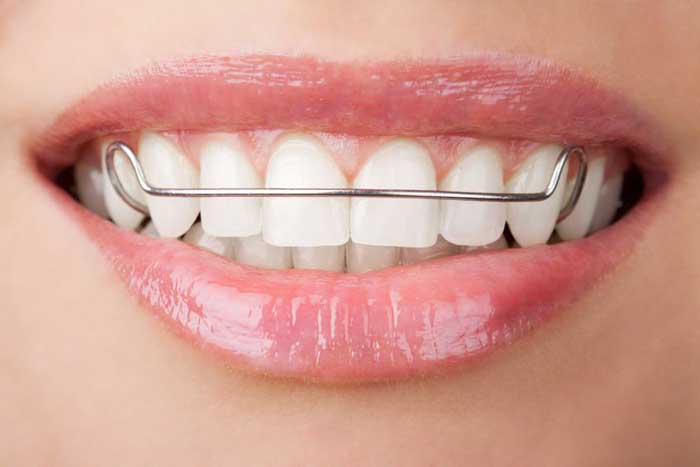Orthodontic treatment is one of the branches of dentistry that deals with malocclusion where each set of teeth are incorrectly aligned with each other, and therefore cannot give a proper bite.
It also specializes in making teeth straight. The aim of orthodontic treatment is not only cosmetic but also to improve oral health. It can close gaps between teeth, give better alignment, in addition to helping in speech and boost gum and teeth health.
Orthodontic treatment focuses on teeth misalignment. It can straighten crooked teeth, correct your bite (occlusion) and realign your jaw. This treatment can also help with sleep apnoea, bruxism, and lifestyle issues. All these treatments are required by different age groups and people from different lifestyles. In orthodontic treatment, all the cases that come to the dentist, are treated differently according the age, lifestyle, and problem they are there in the first place.
Who can benefit from orthodontic treatment?
People of all ages benefit from the orthodontic treatment. Beginning with children whose milk teeth have appeared but who have yet to develop permanent teeth, through children who have problems in eruption of new permanent teeth, to adults who have incorrect bite – overbite, underbite or cross bite. It can also be used for people who have crooked teeth, skeletal deformities of misaligned jaws, or if jaws need to be stimulated for bone remodelling.
How can you decide whether you need orthodontic treatment?
Usually it is your personal physician or your registered dentist who can tell you if you need an appointment with an orthodontist. They will require the tests to decide whether you need orthodontic treatment.
Tests required to decide whether you are suitable to undergo the treatment: medical health history, dental health reports, clinical examinations, plaster models of your teeth, X rays and photographs of teeth.
If your x rays and photographs along with other tests determine that you have overbite, underbite, crossbite, open bite, misplaced midline, spacing, and crowding, then orthodontic treatment will be recommended.
There are many kinds of orthodontic treatments that can be applied to specific need of the patient, depending on when and how they can help the patient to straighten their teeth.
Preventive, Interceptive, and comprehensive treatment are used at different stages of teeth eruption in young children, middle age children and young adults and adults.
Preventive Orthodontics
This is used when the dentist must prepare the mouth for permanent teeth to erupt. The candidates are young children who are ready to get permanent teeth in their mouth.
Sometimes milk teeth disrupt the eruption of permanent teeth and need to be removed to facilitate easy and straight permanent teeth eruption. Although removal of milk teeth is not required very often, as the modern technique of orthodontics allows the use of expanders which can increase the length of dental arch, giving more room to the emerging tooth.
Interceptive orthodontics
This is also performed at an early age. It concerns itself with removing the cause of orthodontic problem before it becomes serious. Interceptive orthodontic treatment is required when the jaw of the child is relatively small and may not have enough space to allow new tooth to erupt. In such a case, the orthodontic surgeon can use the palate expander device which expands the size of the jaw to give enough room to new emerging tooth.
Comprehensive orthodontic treatment
This is focused on fixed appliances like braces to gradually move the teeth to give them a proper bite. There is no age limit for this kind of orthodontic treatment, and it can be availed of as early as teenage. Comprehensive treatment allows for dental surgery along with the braces.
Braces
This is the most common orthodontic treatment. Braces are fixed appliance that consist of bands, wires, and brackets. Bands keep the appliance in place and brackets are bonded to the tooth. Wires are attached to the bands passing through brackets. Arch wires are used to put mild pressure on the teeth to make them move in the desired direction. Braces must be readjusted at regular interval to monitor the movement of the teeth and tighten the wires to make up for the movement occurred. The results may appear in a few months or few years depending on various factors.
The candidate should have all the permanent teeth erupted and fully functional to be able to benefit from this treatment. The candidate should be healthy and should be able to follow the dentist’s instructions for oral health regime. This treatment goes on for a few months to few years depending on the age of the candidate. When working with young adults, the movement of teeth is easier than with adults above 25 or more years.
There are different materials available for braces like stainless steel and gold, and invisible like Invisalign or lingual. The choice of material for the braces depends on the cost and personal preference.
The prospective candidate must have time to keep the appointed time with the orthodontist at regular intervals because this treatment requires to monitor the movement of teeth and make adequate changes in the appliances.
Surgical orthodontic treatment
This treatment is used for specific jaw or teeth abnormalities which cannot be treated by any other treatment. In some cases, the jawbone protrudes outside extensively which cannot be treated with braces, because braces can only correct the teeth movement not the jaw. In such a case jawbone surgery is needed to correct the abnormality to correct the teeth alignment. Similarly, when the jawbone is recessed inward, the orthodontic surgeon will perform surgery to bring the jawbone with alignment to the other jaw, upper or lower.

